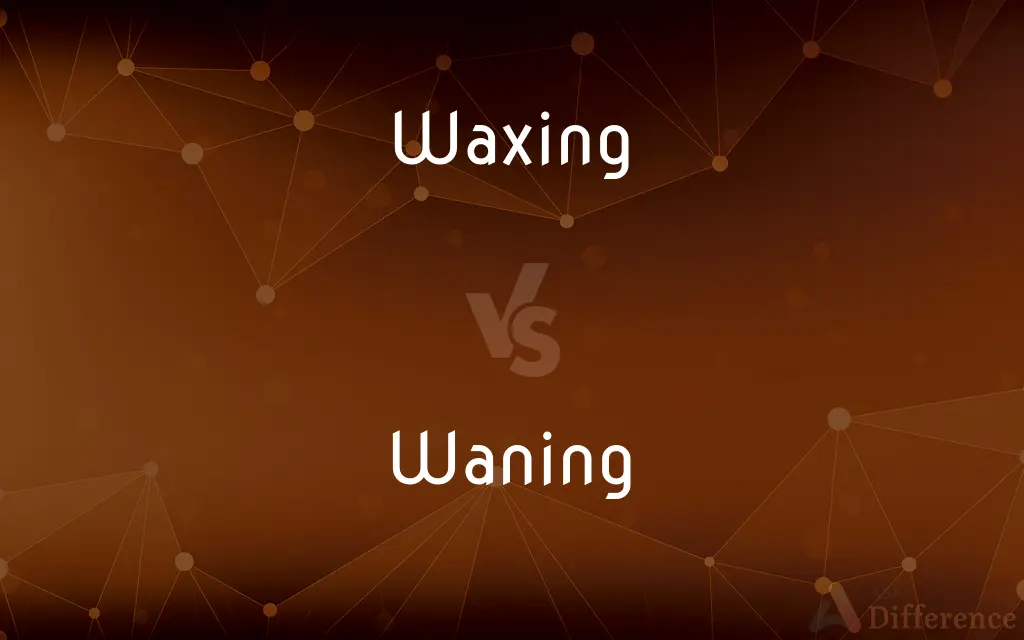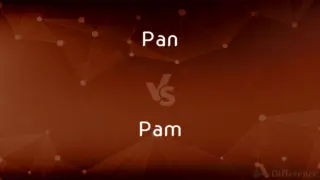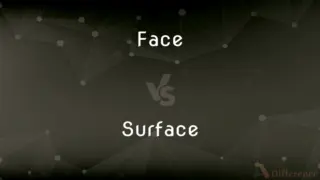Waxing vs. Waning — What's the Difference?
By Tayyaba Rehman — Updated on September 21, 2023
Waxing refers to an increase, often related to the moon's visible surface, while waning denotes a decrease or decline.

Difference Between Waxing and Waning
Table of Contents
ADVERTISEMENT
Key Differences
Waxing and waning are terms most commonly associated with the phases of the moon. Waxing describes the process when the moon's illuminated surface, as seen from Earth, is increasing. On the flip side, waning refers to the phase where the illuminated portion of the moon is decreasing.
However, these terms aren't exclusively lunar. Waxing can describe anything that's increasing or growing. For instance, one might talk about the waxing interest in a particular hobby or trend. In contrast, waning can be applied to anything diminishing or reducing, such as waning enthusiasm or waning daylight as the evening approaches.
In a broader context, waxing often carries a positive connotation, suggesting growth, enhancement, or a surge. Waning, conversely, can imply a decrease or a fading away of something, which might be viewed in a negative light or merely as a natural decline.
In summary, waxing and waning are dynamic opposites. While waxing implies an increase, be it in the context of the moon's phase or a rising trend, waning denotes a decrease or decline, whether referencing the moon or a diminishing interest.
Comparison Chart
Meaning
Increasing or growing
Decreasing or diminishing
ADVERTISEMENT
Contextual Usage
Often positive, suggesting growth
Often indicates decline or reduction
Association
Commonly linked with the moon's illuminated phase
Linked with the moon's diminishing illuminated phase
Temporal Connotation
Suggests a rise or surge
Implies a fading or end
Broader Application
Can describe increasing interest or trend
Can denote a decreasing enthusiasm or popularity
Compare with Definitions
Waxing
Increasing in size or magnitude.
The waxing popularity of the show was evident from its ratings.
Waning
Moving towards an end.
The waning hours of the event were the most memorable.
Waxing
Referring to the moon's phase when its visible surface enlarges.
The waxing crescent moon was beautifully visible just after sunset.
Waning
Referring to the moon's phase when its visible surface reduces.
The waning gibbous moon was still quite bright in the night sky.
Waxing
Strengthening or intensifying.
Her waxing determination was evident in her efforts.
Waning
Declining in influence or popularity.
The waning days of summer always brought a touch of melancholy.
Waxing
Growing or expanding in scope.
His waxing influence in the community was undeniable.
Waning
Fading or diminishing over time.
The old tradition was waning, with few people practicing it now.
Waxing
Applying a substance to give shine or protection.
She spent the afternoon waxing her car to a perfect shine.
Waning
Decreasing in strength or intensity.
His waning interest in the project became apparent.
Waxing
Waxing is the process of hair removal from the root by using a covering of a sticky substance, such as wax, to adhere to body hair, and then removing this covering and pulling out the hair from the follicle. New hair will not grow back in the previously waxed area for four to six weeks, although some people will start to see regrowth in only a week due to some of their hair being on a different human hair growth cycle.
Waning
To decrease gradually in size, number, strength, or intensity
Interest in the subject waned.
Waxing
Any of various natural, oily or greasy heat-sensitive substances, consisting of hydrocarbons or esters of fatty acids that are insoluble in water but soluble in nonpolar organic solvents.
Waning
To show a progressively smaller illuminated area, as the moon does in passing from full to new.
Waxing
Beeswax.
Waning
To approach an end
The day began to wane.
Waxing
Earwax.
Waning
The act or process of gradually declining or diminishing.
Waxing
A solid plastic or pliable liquid substance, such as ozocerite or paraffin, originating from petroleum and found in rock layers and used in paper coating, as insulation, in crayons, and often in medicinal preparations.
Waning
A time or phase of gradual decrease.
Waxing
A preparation containing wax used for polishing floors and other surfaces.
Waning
The period of the decrease of the moon's illuminated visible surface.
Waxing
A resinous mixture used by shoemakers to rub on thread.
Waning
A defective edge of a board caused by remaining bark or a beveled end.
Waxing
A cosmetic procedure in which facial or body hair is removed by peeling away a layer of wax that has been allowed to harden.
Waning
Present participle of wane
Waxing
Made of wax
A wax candle.
Waning
Becoming weaker or smaller.
His waning strength
Waxing
To coat, treat, or polish with wax.
Waning
Of the lunar phase: as it shrinks when viewed from the Earth.
The waning moon
Waxing
To remove (facial or body hair) by covering the skin with a layer of wax that is peeled off after hardening, uprooting the encased hairs.
Waning
The fact or act of becoming less or less intense or present; fading.
The waning of her energy
Waxing
To remove hair from (a portion of the body) by this method.
Waning
The fact or act of becoming smaller.
Waxing
To increase gradually in size, number, strength, or intensity
“His love affair with Mrs. Bernstein waxed and waned and waxed again” (C. Hugh Holman).
Waning
The act or process of waning, or decreasing.
This earthly moon, the Church, hath fulls and wanings, and sometimes her eclipses.
Waxing
To show a progressively larger illuminated area, as the moon does in passing from new to full.
Waning
A gradual decrease in magnitude or extent;
The waning of his enthusiasm was obvious
The waxing and waning of the moon
Waxing
To grow or become as specified
“His very body had waxed old in lowly service of the Lord” (James Joyce).
Waning
(of the moon) pertaining to the period during which the visible surface of the moon decreases;
After full moon comes the waning moon
Waxing
To speak or write as specified
“[He] warmed to his most favorite of subjects, waxed eloquent, gained in his face a glow of passion” (Paul J. Willis).
Waxing
The action of the verb to wax.
Waxing
(countable) A cosmetic procedure in which hair is removed from the body by the application and removal of wax.
Waxing
(countable) A recording intended for a phonograph.
Waxing
The application of wax to a surface
Waxing
A gradual increase in magnitude or extent;
The waxing of the moon
Waxing
(of the moon) pertaining to the period during which the visible surface of the moon increases;
The waxing moon passes from new to full
Common Curiosities
How long does the waxing phase of the moon last?
The waxing phase lasts from the new moon to the full moon, about half of the lunar cycle or roughly 14 days.
Is waxing always positive and waning negative?
Contextually, waxing often has a positive connotation, while waning might be neutral or negative, but this isn't absolute.
Can we use waxing to describe growing enthusiasm?
Yes, waxing can be used to describe increasing enthusiasm or interest.
Can waning be used outside of lunar contexts?
Absolutely, waning can describe any diminishing or decreasing phenomenon.
What follows a waning gibbous moon?
After the waning gibbous phase, the moon enters its waning crescent phase.
Does waning mean the moon is disappearing?
Waning means the moon's illuminated portion is decreasing, but the moon itself isn't disappearing.
Does waxing always refer to visible growth?
Mostly, but it can also metaphorically describe intangible growth, like influence or enthusiasm.
What does waxing mean in terms of the moon?
Waxing refers to the moon's phase when its visible surface, as seen from Earth, is increasing.
Can waning be used to describe interests or trends?
Yes, waning can describe diminishing interests or declining trends.
Is waxing crescent before or after a new moon?
Waxing crescent comes after the new moon and before the first quarter moon.
When is the moon's visibility at its least during waning?
The moon's visibility is at its least during the waning crescent, right before the new moon.
Is waxing related to applying wax?
Yes, "waxing" can also refer to the act of applying wax to surfaces for shine or protection.
What phase comes after the waxing crescent?
After the waxing crescent phase, the moon enters its first quarter phase.
What signifies the end of the waning phase?
The new moon marks the end of the waning phase and the beginning of the waxing phase.
Can waxing describe a surge in popularity?
Yes, waxing can describe a rising trend or surge in popularity.
Share Your Discovery

Previous Comparison
Pan vs. Pam
Next Comparison
Face vs. SurfaceAuthor Spotlight
Written by
Tayyaba RehmanTayyaba Rehman is a distinguished writer, currently serving as a primary contributor to askdifference.com. As a researcher in semantics and etymology, Tayyaba's passion for the complexity of languages and their distinctions has found a perfect home on the platform. Tayyaba delves into the intricacies of language, distinguishing between commonly confused words and phrases, thereby providing clarity for readers worldwide.















































